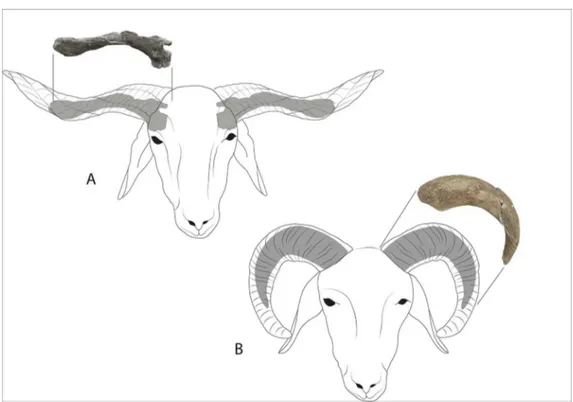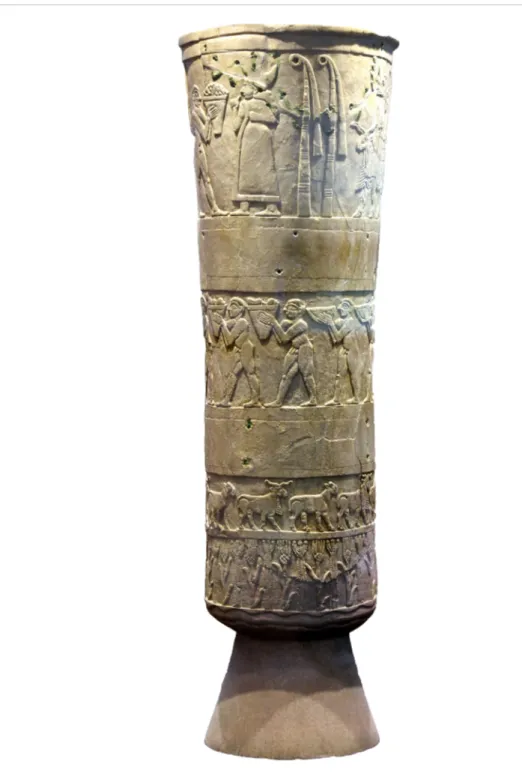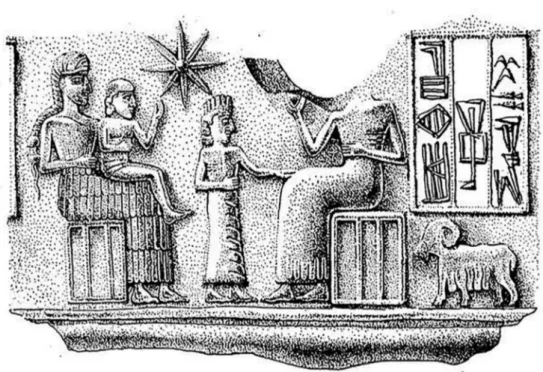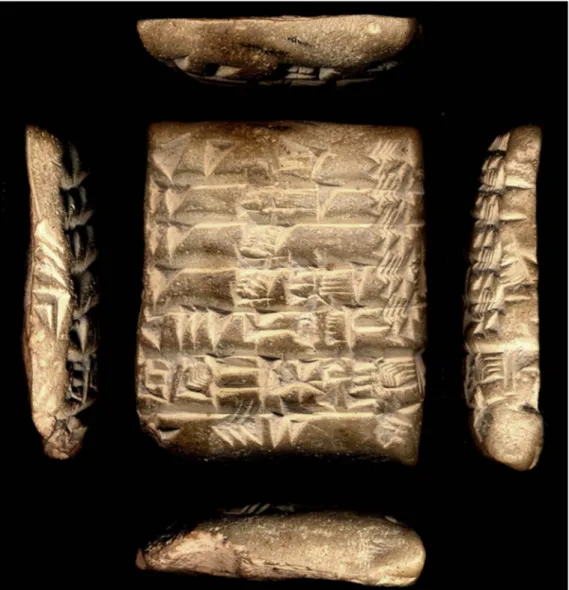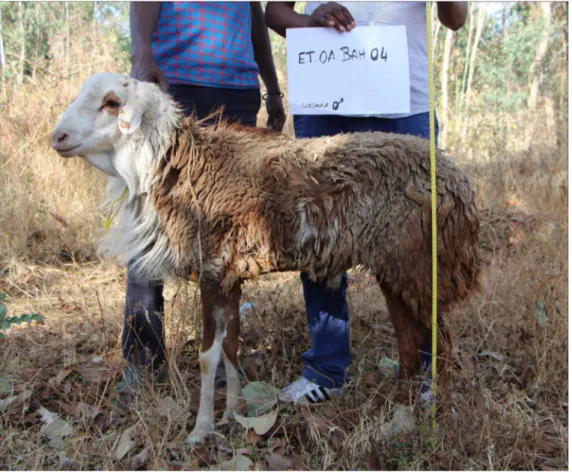Project Gallery
EVOSHEEP: the makeup of sheep breeds in the
ancient Near East
Emmanuelle Vila1,* , Philippe Abrahami2 , Moussab Albesso1, Agraw Amane3,4, Camille Bader5, Rémi Berthon5 , Sofiane Bouzid1, Daniel Bradley6 ,
Catherine Breniquet7, Jwana Chahoud1,8 , Thomas Cucchi5 , Hossein Davoudi9, Bea de Cupere10 , Gilles Escarguel11 , Oscar Estrada12 , Lionel Gourichon13 , Daniel Helmer1, Wei Huangfu14, Joséphine Lesur5 , Marjan Mashkour5,9 , Cécile Michel15 , Azadeh Mohaseb5,9, Ludovic Orlando12, François Pompanon16, Jacqueline Studer17& Manon Vuillien13
1Archéorient, CNRS, University of Lyon 2, France 2HALMA, CNRS, University of Lille, France 3
Department of Microbial, Cellular and Molecular Biology, Addis Ababa University, Ethiopia 4ILRI, Livestock Genetics Program, Addis Ababa, Ethiopia
5AASPE, Muséum national d’Histoire naturelle, CNRS, Paris, France 6Smurfit Institute of Genetics, Trinity College, Ireland
7University Clermont Auvergne, CHEC, Clermont-Ferrand, France 8
Department of Archaeology, Lebanese University, Lebanon
9Archaeozoological section, Bioarchaeological laboratory, University of Tehran, Iran 10
Directorate Earth and History of Life, Royal Belgian Institute of Natural Sciences, Belgium 11LEHNA, CNRS, University of Lyon 1, ENTPE, France
12AMIS, CNRS, University of Toulouse III, France 13CEPAM, CNRS, University Côte d’Azur, France
14Maison de l’Orient et de la Méditerranée, CNRS, University of Lyon 2, France 15ArScAn, CNRS, Nanterre, France
16LECA, University Grenoble Alpes/CNRS, France
17Department of Archaeozoology, Natural History Museum, Geneva, Switzerland * Author for correspondence:✉emmanuelle.vila@mom.fr
The EVOSHEEP project combines archaeozoology, geometric morphometrics and genetics to study archaeo-logical sheep assemblages dating from the sixth to thefirst millennia BC in eastern Africa, the Levant, the Ana-tolian South Caucasus, the Iranian Plateau and Mesopotamia. The project aims to understand changes in the physical appearance and phenotypic characteristics of sheep and how these related to the appearance of new breeds and the demand for secondary products to supply the textile industry.
Keywords: Africa, Levant, Near East, sheep, archaeozoology, geometric morphometrics, textile production
Introduction
The Near East is the cradle of sheep domestication. Since the ninth millennium BC, sheep have played a major role in societal development, and have been an important element in
Received: 17 December 2019; Revised: 26 April 2020; Accepted: 12 May 2020
© The Author(s), 2021. Published by Cambridge University Press on behalf of Antiquity Publications Ltd. This is an Open Access article, distributed under the terms of the Creative Commons Attribution licence (http://creativecommons. org/licenses/by/4.0/), which permits unrestricted re-use, distribution, and reproduction in any medium, provided the original work is properly cited.
Antiquity2021 Vol. 95 (379): e2, 1–8
many different spheres of human activity (Vigne et al.2005,2017). Despite numerous stud-ies on the domestication of a variety of plants and animals using a range of bioarchaeological methods, few have investigated the development of breeding and zootechnical practices by thefirst herders (e.g. Zeder et al. 2006; Colledge et al. 2013; Cucchi et al. 2016; Pöllath et al.2019; Balasse et al.2019). This is partly due to the difficulty in obtaining evidence
of such activities using traditional zooarchaeological methods, for example, in the identifica-tion of phenotypical or physiological features transmitted from one generaidentifica-tion to the next, and related to a particular domesticated population.
The domestication process resulted in behavioural, functional and anatomical changes in sheep. Due to the ethological and eco-physiological characteristics of this species, it can tol-erate a broad range of geo-climatic conditions (Ryder1983). Both natural and artificial
selec-tion have played important roles in producing adaptive traits, resulting in breeds that have been selected for specific climates, available vegetation and resistance to local diseases and parasites (Pilling & Rischkowsky2007).
Sheep provide diverse food products (meat, fat and milk) and craft materials (hide, fleece, tendons, horn and bone), as well as manure fertiliser. Some products (called secondary products) can be obtained repeatedly throughout the animal’s life, such as milk, which has high nutritional value, and wool, a raw material with exceptional properties (Sher-ratt1983).
Figure 1. A) Horizontal spiral horn core of a Late Chalcolithic sheep (Tell Sheikh Hassan, Syria, Uruk period); B) coiled horn core of an Early Bronze Age sheep (Kharab Sayyar, Syria, third millennium BC) (photographs by E. Vila; drawings by F. Truxa).
Figure 2. Uruk-Warka (Iraq), Uruk period. Lower register: row of sheep; rams with horizontal spiral horns and a mane (detail of Warka Vase, Iraq Museum); available at:https://commons.wikimedia.org/w/index.php?curid=78821078 (accessed 4 December 2020); CC BY-SA 4.0).
The origins of sheep breeds: the zooarchaeological and textual clues
Approximately 1000 ovine breeds are present today throughout the world, resulting from a complex history of natural and human selection that has enriched the phenotypic diversity in sheep (Scherf & Pilling2015). The process of breed emergence is still poorly understood, however, particularly regarding the diversity of domestic phenotypes, the role of environmen-tal conditions and zootechnical innovations responsible for the emergence of breeds, as well as the role of secondary products. To address these issues, the EVOSHEEP project—funded by the French National Research Agency—launched in autumn 2018.
Mortality profiles provide the earliest indirect evidence of sheep-milk production, which can be dated to the eighth millennium BC, andfleece production dating to the seventh mil-lennium BC (Helmer et al.2007). By the sixth millennium BC in the Near East, an increase in artefacts related to fleece handling, such as spindle whorls, is indicative of textile fibre-processing of both animal and vegetal origin (Rooijakkers2012).
In northern Mesopotamia, an important increase in sheep husbandry during the fourth millennium BC (Uruk period) can be identified (Vila & Chahoud2019). Zooarchaeological studies have shown that these animals are larger than earlier sheep (Vila & Helmer2014). Their horns form horizontal spirals, which are similar in shape to those of contemporaneous Levantine and Egyptian sheep (Figure 1a&Figure 2). At the beginning of the third millen-nium BC (Early Bronze Age), the average sheep size was smaller, and the horns were coiled
Figure 3. Detail of a seal from Mozan (Syria), third millennium BC: ram with coiled horns and woolly coat (taken from Buccellati & Kelly-Buccellati1995–1996:fig. 4b).
(Figure 1(b)). Iconographic depictions from this period often show a well-developed woolly coat (Figure 3) (Vila & Helmer 2014). Mesopotamian texts mention a diversity of sheep types of various origins as early as the third millennium BC (Figure 4), and later textual descriptions of wool quality and colour in the Near East and Aegean regions also confirm this diversity (Breniquet & Michel2014). One hypothesis, therefore, is that woolly sheep breeds were favoured by urban development and the associated increasing demand for textile production.
Figure 4. Tablet in Sumerian (Ur III) that mentions a fat-tailed sheep. Anonymous collection (CDLI P313095; photograph courtesy of B. Englund).
Research questions
EVOSHEEP is a multidisciplinary project combining archaeozoology, geometric morpho-metrics and genetics to study archaeological sheep assemblages that date from the sixth to thefirst millennia BC in eastern Africa, the Levant, the Anatolian South Caucasus, the Iran-ian Plateau and Mesopotamia. In addition, the project incorporates a historical approach based on Sumerian-Akkadian texts and ancient Near Eastern iconography.
The following research topics will be investigated:
1) How did environmental factors and husbandry practices play a role in the biological and physical modifications of sheep compared with their wild ancestors?
2) When and where did major phenotypic characteristics, such as a fat tail, woollyfleece, pigmentation and lack of moulting, appear?
3) Did the herders’ interest in secondary products (e.g. fleece, milk) con-tribute to the selection of new phenotypic traits?
4) Is there a relationship between regional variation in sheep size and horn-core morphology and the emergence of different varieties or breeds?
Figure 5. Washera breed, Ethiopia (photograph by E. Vila).
5) How did the development of the textile industry during the third mil-lennium BC affect sheep herding and urban development in South-west Asia?
6) Werefleece quality and pigmentation critical factors in the development of the textile industry and dyeing techniques?
To address these issues, EVOSHEEP will perform three-dimensional geometric morpho-metric analysis of selected bones with discriminating morphological markers (the humerus, astragalus, calcaneus and petrous bone). The genetic approach, based on the study of present-day genetic variation in a large range of breeds and populations, will be used to identify key genomic regions associated with important phenotypic traits (e.g. tail, coat, horns and col-our), followed by palaeogenetic analyses of archaeological bones. EVOSHEEP also aims to create an osteological reference collection of present-day sheep breeds from the Middle East (Iran, Lebanon) and Africa (Ethiopia) (Figure 5). An online, open-access database is cur-rently under development on a dedicated website.
Acknowledgements
The project is coordinated by a consortium of five partner laboratories: Laboratoire Archéorient—Environnements et Sociétés de l’Orient Ancien (coordinated by E. Vila); Archéozoologie, Archéobotanique: Sociétés, Pratiques et Environnements (coordinated by M. Mashkour); Anthropobiologie Moléculaire et d’Imagerie de Synthèse (coordinated by L. Orlando); Laboratoire d’Écologie Alpine (coordinated by F. Pompanon); and the Smurfit Institute of Genetics (coordinated by D. Bradley). It also benefits from collaborations with French archaeological missions of the Ministry of Europe and Foreign Affairs, other European archaeological expeditions, the General Directorates of Antiquities, as well as academic institu-tions in Armenia, Azerbaijan, Georgia, Ethiopia, Lebanon, Iran, Iraq, Sudan, Syria and Turkey.
Funding statement
The EVOSHEEP project is funded by the French National Research Agency (ANR PRC Project: ANR-17-CE27-0004).
References
Balasse, M., A. Tresset, G. Obein, D. Fiorillo & H. Gandois. 2019. Seaweed-eating sheep and the adaptation of husbandry in Neolithic Orkney: new insights from Skara Brae. Antiquity 93: 919– 32.https://doi.org/10.15184/aqy.2019.95 Breniquet, C.& C. Michel. 2014. Wool economy
in the ancient Near East and the Aegean. Oxford: Oxbow.https://doi.org/10.2307/j.ctvh1djjn Buccellati, G.& M. Kelly-Buccellati. 1995–
1996. The royal storehouse of Urkesh: the glyptic evidence from the southwestern wing. Archiv für Orientforschung 42/43: 1–32.
Colledge, S., J. Conolly, K. Dobney,
K. Manning& S. Shennan. 2013. The origins and spread of domestic animals in Southwest Asia and Europe. Walnut Creek (CA): Left Coast. https://doi.org/10.1179/1461957115Z. 000000000120
Cucchi, T., L. Dai, M. Balasse, C. Zhao, J. Gao, Y. Hu, J. Yuan & J.-D. Vigne. 2016. Social complexification and pig (Sus scrofa) husbandry in ancient China: a combined geometric morphometric and isotopic approach. PLoS ONE 11: e0158523. https://doi.org/10.1371/journal.pone.0158523
Helmer, D., L. Gourichon & E. Vila. 2007. The development of the exploitation of products from Capra and Ovis (meat, milk andfleece) from the PPNB to the Early Bronze in the northern Near East (8700 to 2000 BC cal.). Anthropozoologica 42(2): 41–69.
Pilling, D.& B. Rischkowsky. 2007. Animal genetic resources and resistance to disease, in B. Rischkowsky & D. Pilling (ed.) The state of the world’s animal genetic resources for food and agriculture: 101–12. Rome: FAO.
Pöllath, N., R. Schafberg & J. Peters. 2019. Astragalar morphology: approaching the cultural trajectories of wild and domestic sheep applying geometric morphometrics. Journal of
Archaeological Science: Reports 23: 810–21. https://doi.org/10.1016/j.jasrep.2018.12.004 Rooijakkers, C.T.2012. Spinning animalfibres at
Late Neolithic Tell Sabi Abyad, Syria? Paléorient 38(1–2): 93–109.
https://doi.org/10.3406/paleo.2012.5461 Ryder, M.L.1983. Sheep and man. London:
Duckworth.
Scherf, B.& D. Pilling. 2015. The second report on the state of the world’s animal genetic resources. Rome: Commission on Genetic Resources for Food and Agriculture Assessments (FAO). Sherratt, A.1983. The secondary exploitation of
animals in the Old World. World Archaeology 15: 90–104.
https://doi.org/10.1080/00438243.1983. 9979887
Vigne, J.-D., J. Peters & D. Helmer. 2005. The first steps of animal domestication: new
archaeological approaches. Oxford: Oxbow. Vigne, J., L. Gourichon, D. Helmer, L. Martin
& J. Peters. 2017. The beginning of animal domestication and husbandry in Southwest Asia, in Y. Enzel & O. Bar-Yosef (ed.) Quaternary of the Levant: 753–60. Cambridge: Cambridge University Press.
https://doi.org/10.1017/9781316106754.084 Vila, E.& J. Chahoud. 2019. Sheep husbandry
from the sixth to the third millennia BC in the Near East: a launching pad for the Mesopotamian urban revolution? in L. Gourichon, C. Daujeard & J.-P. Brugal (ed.) Humans and caprines: 203– 23. Antibes: APDCA.
Vila, E.& D. Helmer. 2014. The expansion of sheep herding and the development of wool production in the ancient Near East: an archaeozoological and iconographical approach, in C. Breniquet & C. Michel (ed.) Wool economy in the ancient Near East and the Aegean: 22–40. Oxford: Oxbow. https://doi.org/10.2307/j.ctvh1djjn
Zeder, M.A., D. Bradley, E. Emshwiller & B.D. Smith. 2006. Documenting domestication: new genetic and archaeological paradigms. Berkeley: University of California Press. https://doi.org/10.1016/j.tig.2006.01.007
